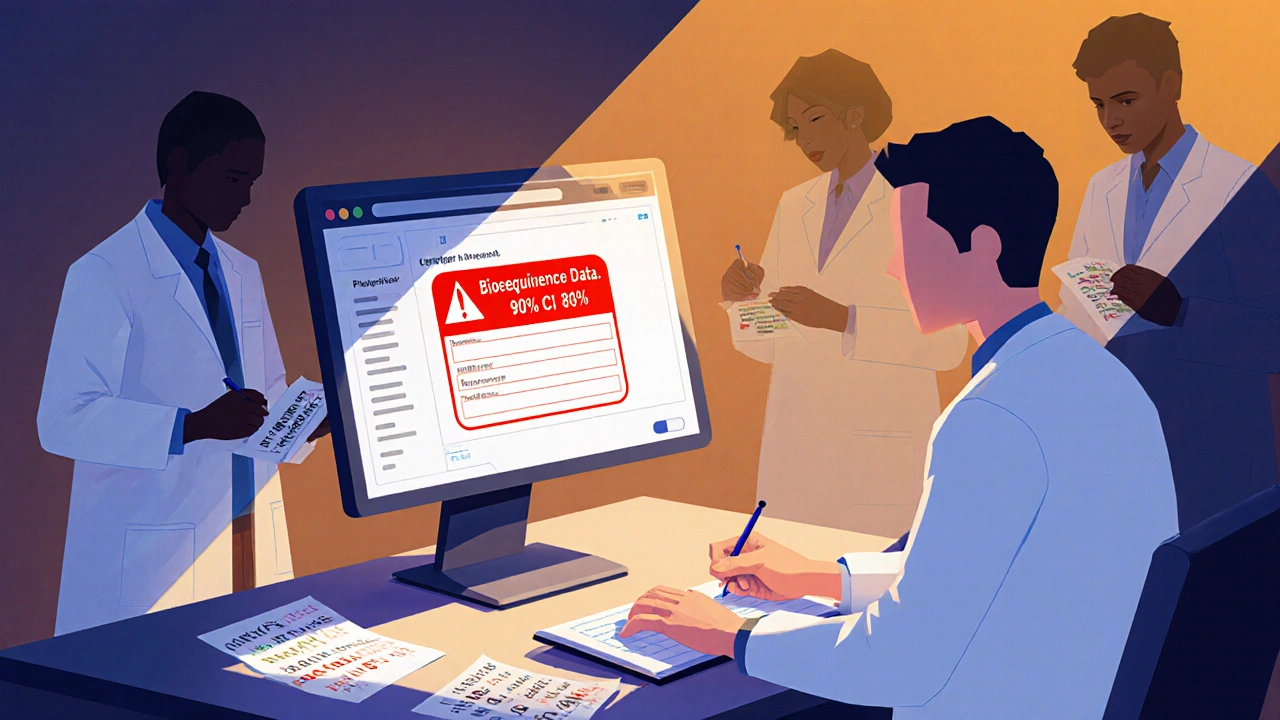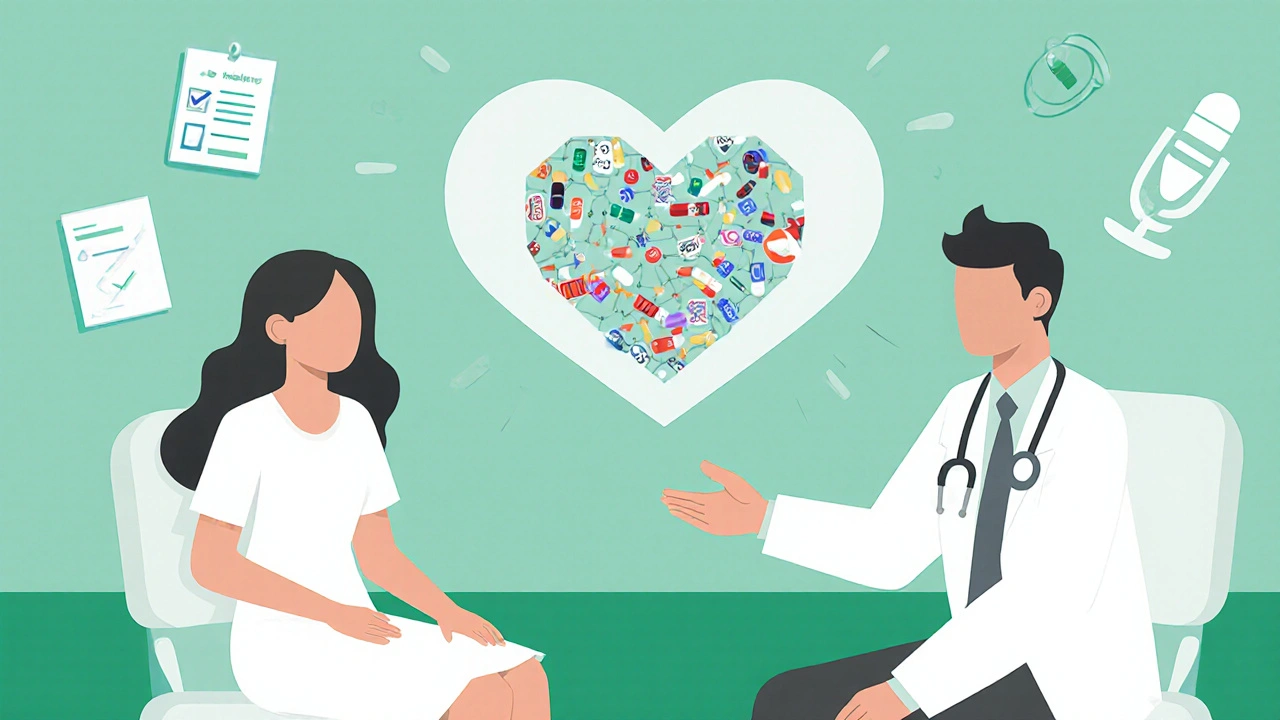Doctors prescribe generics for 90% of all medications dispensed in the U.S., yet only 31% use the International Nonproprietary Name (INN) when writing prescriptions. Why? Because most doctors weren’t taught how to think about generics like they think about brand-name drugs. They learned the brand names in medical school, saw them on rounds, and heard senior physicians say, "Stick with the brand." The science says generics are equivalent. The system says they’re cheaper. But the training? It’s missing.
What Bioequivalence Really Means
When the FDA approves a generic drug, it doesn’t just check that it looks the same or has the same ingredient. It requires proof that the active drug enters the bloodstream at the same rate and to the same extent as the brand. That’s bioequivalence. The standard? The 90% confidence interval for AUC and Cmax must fall between 80% and 125%. That’s not a guess. It’s a statistical requirement tested in 24 to 36 healthy volunteers. For most drugs, that’s enough to guarantee the same clinical effect.
But here’s what no one tells you in med school: this rule applies to every drug class - even ones with narrow therapeutic indexes like warfarin, levothyroxine, or phenytoin. Neurologists sometimes hesitate to switch epilepsy patients to generics, fearing instability. Yet the FDA’s data shows no increased risk of seizures with bioequivalent generics. The same goes for thyroid meds. The science doesn’t make exceptions. The fear does.
What Doctors Actually Learn (and Don’t Learn)
A 2024 survey of 3,872 U.S. physicians found that 89% agreed generics are generally equivalent. But only 54% felt confident explaining bioequivalence to a patient. Why? Because in most medical curricula, pharmacology courses spend 12 hours on brand-name drug mechanisms and less than 30 minutes on generic substitution. Case studies use brand names. Exams test brand names. Even the textbooks rarely mention INN prescribing.
At Karolinska Institute in Sweden, they changed that in 2018. They made INN prescribing mandatory in student evaluations. Graduates now prescribe generics by name 47% more often than before. It wasn’t a lecture. It was a rule. And it worked.
In Malaysia, a 45-minute interactive session with a pharmacist - covering bioequivalence, myths, and how to prescribe by INN - boosted doctors’ knowledge scores from 58.7% to 84%. But here’s the catch: their prescribing habits didn’t change. Why? Because when junior doctors saw senior doctors writing "Lipitor" instead of "atorvastatin," they copied them. Culture beats curriculum.
The Real Barrier Isn’t Knowledge - It’s Behavior
Doctors aren’t resistant because they’re ignorant. They’re resistant because they’re overwhelmed. You’ve got 12 to 18 seconds per prescription. You’re juggling drug interactions, insurance formularies, patient history, and now, whether to write a brand or generic. If the system doesn’t make the right choice easy, you default to what’s familiar.
And the familiar is the brand name. It’s what you saw in residency. It’s what the rep gave you. It’s what your mentor used. Even when you know generics are equivalent, you write the brand because it feels safer. It’s not about the drug. It’s about the habit.
One family doctor in Texas tried something different. After every prescription, he asked his patients: "Can you tell me why we’re using this generic?" He called it the teach-back method. Within months, patient questions about generics dropped by 63%. Why? Because patients trusted him more when he explained it clearly - and when they understood, they were less likely to refuse.

Where the System Fails Doctors
Only 38% of U.S. healthcare systems have electronic health records that flag generic substitution opportunities or show bioequivalence data at the point of care. Most doctors still have to Google it. Or ask a pharmacist. Or guess.
Then there’s the Concerta situation. In 2016, some patients reported reduced effectiveness with a specific generic methylphenidate. The FDA reviewed the data and confirmed the generic met all bioequivalence standards. But the perception stuck. Doctors who had one bad experience stopped switching. One patient’s report became a rule of thumb. That’s not science. That’s trauma.
And it’s not just U.S. doctors. In Japan, only 23% of prescriptions are for generics. In Germany, it’s 91%. The difference? Not access. Not cost. Education. Reimbursement. And trust in the system.
What Works - and What Doesn’t
Passive education - printed handouts, PDFs, one-off lectures - improves knowledge by 7.2%. That’s it. No change in behavior.
Interactive training - like the Malaysian study - improves knowledge by 25%. Still no change in behavior.
But when you combine feedback with real prescribing - like the pharmacist training model that requires reviewing 2,000 prescriptions - retention jumps 40%. Add the teach-back method, and you get lasting change.
Here’s what actually moves the needle:
- Mandatory INN prescribing in medical school evaluations
- EHR alerts that show bioequivalence data when you open a prescription
- Feedback loops - monthly reports on your generic prescribing rate
- Teach-back with patients - not just for generics, but for all meds
- Using generic names in rounds, case studies, and exams
The FDA’s new microlearning modules - 15-minute videos on bioequivalence - are a start. But they’re not enough. You can’t fix a systemic problem with a YouTube playlist.

The Economic Case Is Clear
Generics make up 90% of prescriptions but only 22% of drug spending. In 2023, the global generic market was worth $467 billion. By 2030, it’ll hit $790 billion. That’s not just savings. That’s systemic leverage.
Imagine if every doctor in the U.S. prescribed generics confidently and consistently. The IMS Institute estimates we’d save $156 billion a year by 2030. That’s enough to cover free primary care for millions. But that only happens if doctors stop seeing generics as a compromise - and start seeing them as the standard.
What Needs to Change
Medical education on generics isn’t broken. It’s absent. It’s buried under brand-name bias. To fix it, you need to rebuild the foundation.
- Medical schools must replace brand-name case studies with generic equivalents. Every example. Every exam.
- Residency programs must require INN prescribing in all documentation.
- Hospitals must integrate bioequivalence data into EHRs - not as a footnote, but as a default view.
- Pharmacists must be part of rounds, not just dispensers.
- Providers must be trained to use the teach-back method - not just for generics, but for every prescription.
It’s not about convincing doctors. It’s about changing the system so they don’t have to choose between what’s right and what’s easy.
What You Can Do Today
If you’re a clinician, start small:
- Write one prescription today using the INN. Just one.
- Ask a patient: "Do you know why we’re using this generic?" Then listen.
- Ask your pharmacy: Can you show me the bioequivalence data for this generic?
- Push your department to use generic names in rounds.
If you’re a medical educator: Replace one brand-name example in your lecture with the INN. That’s it. One change. It ripples.
The data is clear. Generics work. The science is solid. The cost savings are massive. The only thing holding us back is the way we were taught to think about them.
Do generic drugs work as well as brand-name drugs?
Yes. By law, a generic drug must demonstrate bioequivalence to the brand-name version - meaning it delivers the same amount of active ingredient into the bloodstream at the same rate. The FDA and EMA require this for every approved generic, even for drugs with narrow therapeutic indexes like warfarin or levothyroxine. Studies show no meaningful difference in clinical outcomes when switching to a bioequivalent generic.
Why do some doctors still prefer brand-name drugs?
Many doctors were trained using brand names in medical school, saw them used by senior colleagues, and associate them with reliability. Even when they know generics are equivalent, the habit sticks. Some also recall isolated patient reports - like the 2016 Concerta situation - and mistakenly assume those cases reflect a broader failure. Workplace culture often overrides scientific training.
Is it safe to switch patients from brand to generic?
For the vast majority of patients, yes. The FDA requires bioequivalence testing for all generics, regardless of drug class. For drugs with narrow therapeutic windows, like antiepileptics or blood thinners, switching is still considered safe if the generic is approved. However, any change should be monitored, especially in the first few weeks. Patient communication is key - explaining why the switch is happening reduces anxiety and improves adherence.
What’s the difference between INN and brand name prescribing?
INN (International Nonproprietary Name) is the generic, scientific name for a drug - like "atorvastatin" or "metformin." Brand names are trademarked - like "Lipitor" or "Glucophage." Prescribing by INN ensures clarity, reduces confusion, and supports cost savings. It’s also the standard in most countries outside the U.S., where brand names dominate prescribing.
Can I trust generics from different manufacturers?
Yes. Every generic manufacturer must meet the same FDA or EMA standards for bioequivalence. While inactive ingredients (fillers, dyes) may differ, these don’t affect how the drug works. The active ingredient is chemically identical. The FDA monitors post-market reports closely - if a generic consistently causes issues, it’s pulled. Most concerns stem from rare, isolated cases, not systemic failure.
How can I learn more about generic drug equivalence?
The FDA offers free 15-minute microlearning modules on bioequivalence through its Generic Drug Education for Healthcare Professionals initiative. The AHRQ also publishes updated prescribing guidelines. For hands-on learning, review your own prescribing patterns - track how often you write generics by INN. Ask your pharmacy for bioequivalence data. Talk to pharmacists. Small steps build confidence.


satya pradeep
Bro, I work in a rural clinic in Bihar. We use generics 100% of the time. Patients don’t care if it’s Lipitor or atorvastatin. They care if it works and if they can afford it. The real issue? Docs who got used to brand names in med school and still write them out of muscle memory. No conspiracy. Just habit.